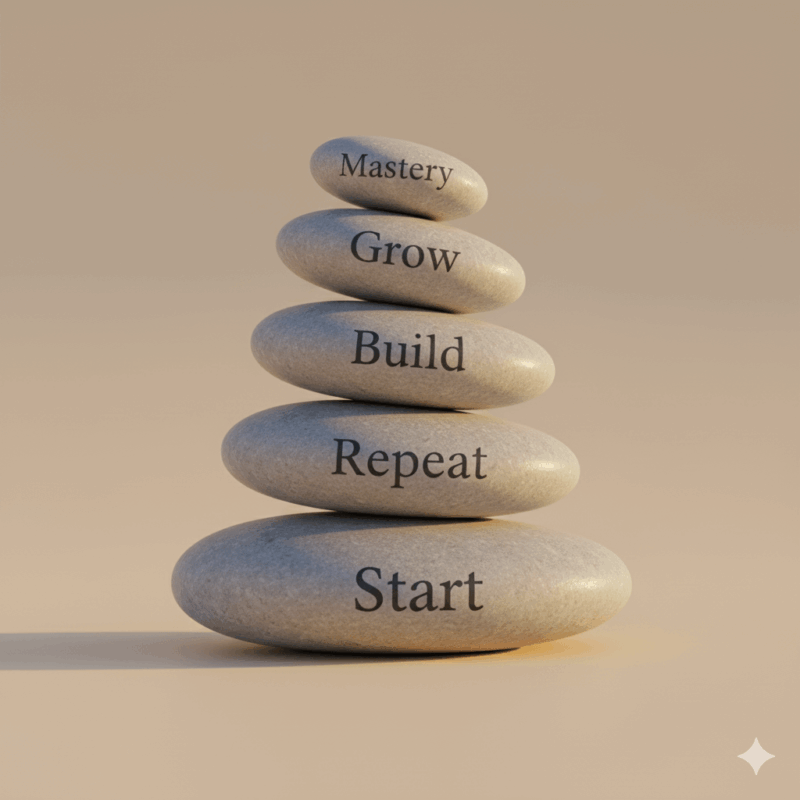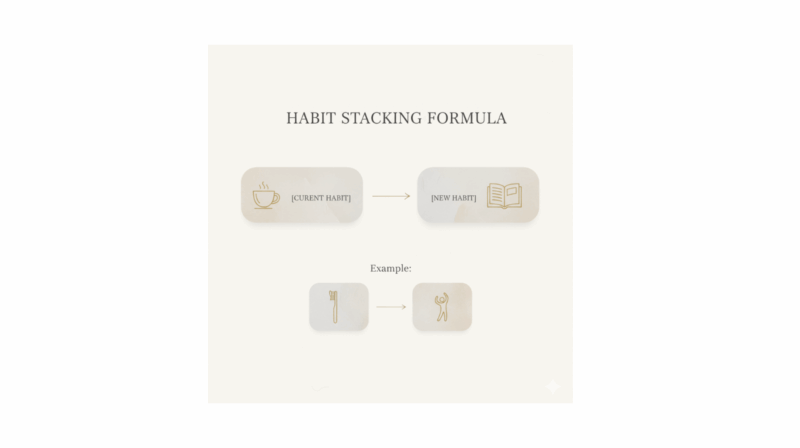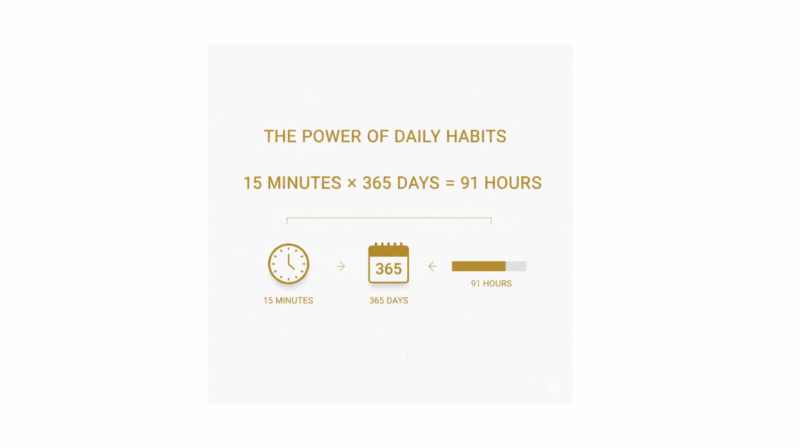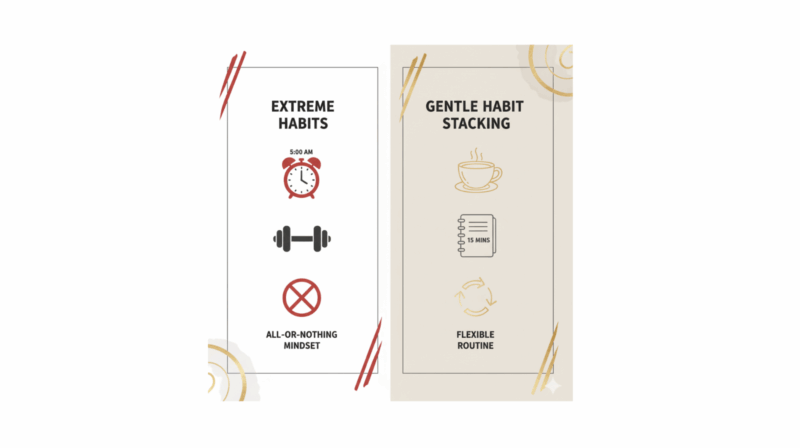Read time: 8 minutes
You keep waiting for the perfect moment to start habit stacking when your schedule clears up, when you have more energy, when everything aligns. But that moment never comes.
Meanwhile, life keeps happening. Work deadlines pile up. Family needs your attention. You’re tired at the end of the day. The big goals you set? Still sitting there, untouched. Weeks turn into months, and you’re left wondering why you can’t make progress on what actually matters to you.
Enter habit stacking. Instead of overhauling your life, you link small 15-minute actions to things you already do—like journaling after your morning coffee. No motivation required. No perfect conditions needed. Just one tiny habit stacked onto your existing routine, building 91 hours of progress over a year without you even noticing the effort
Quick Summary: Waiting for the perfect moment to start never works. Habit stacking links small 15-minute actions to things you already do—like journaling after coffee—building 91 hours of progress yearly without relying on motivation. This guide covers the science, practical examples, and how to start today with just one tiny habit.

Table of Contents
- What Is Habit Stacking? (Definition)
- Why 15-Minute Habit Stacking Works for Beginners
- The Math Behind Habit Stacking
- Science-Backed Benefits of Small Daily Habits
- Habit Stacking Examples for Daily Routines
- How to Start Habit Stacking Today
- What I Learned: Real Beginner Experience
- Common Questions About Habit Stacking
- Your First Step
- Free Habit Stacking Resources
What Is Habit Stacking?
Habit stacking is the practice of linking a new habit to an existing one you already do automatically.
Instead of trying to remember a new habit, you attach it to something that’s already part of your routine.
The formula: After [CURRENT HABIT], I will [NEW HABIT].
This concept comes from James Clear’s book Atomic Habits, where he explains how small habits compound into remarkable results over time.
Examples:
- After I brush my teeth, I will stretch for 2 minutes
- I will make coffee then I will write in my journal
- After I close my laptop, I will do 10 pushups
The power of habit stacking is that your brain already triggers the first habit automatically, so the second habit becomes easier to remember and execute.

Why 15-Minute Habit Stacking Works for Beginners
15 minutes is the sweet spot for beginners because:
- Short enough to start – You can’t talk yourself out of 15 minutes
- Long enough to matter – Real progress happens in this window
- Sustainable – You can do this even on busy days
- Builds momentum – Small wins create confidence
When you link a new habit to something you already do and keep it under 15 minutes, your brain feels like you’re winning. That builds momentum.
The psychological benefit: You’re not adding to your to-do list—you’re transforming time you already have.
The Math Behind Habit Stacking (Why Small Actions Compound)
Here’s the math that changed how I think about time:
15 minutes × 365 days = 91 hours per year
That’s almost four full days a year.
Think about that. Time that usually disappears on your phone could turn into something real.
What 91 hours looks like:
- Learn a language to conversational level (A1 to A2)
- Read approximately 30 books
- Build a consistent meditation practice
- Develop a new skill from beginner to intermediate
This approach isn’t new—it builds on James Clear’s explanation of habit stacking in Atomic Habits, where small, consistent actions attach to habits you already do.
The compounding effect: Each 15-minute session is a vote for the person you’re becoming. After a year, you’ve cast 365 votes. That’s identity change, not just behavior change.

Science-Backed Benefits of Small Daily Habits
You don’t need long workouts or big routines to see real results.
Research on small habit benefits:
Physical Health Benefits
A study with 85,000 participants showed that just 15 minutes of walking each day helped people live approximately 20% longer.
Even small habits improve:
- Sleep quality and duration
- Mental focus and clarity
- Mood stability and emotional regulation
Brain Science: Why Habit Stacking Works
According to the Cleveland Clinic’s guide on habit stacking, linking new habits to familiar routines helps the brain adopt change more easily.
Why this works:
- Your brain runs on neural pathways (mental shortcuts)
- Existing habits have strong pathways already built
- New habits piggyback on these existing pathways
- Less willpower required because the trigger is automatic
Key insight: Doing something small every day is better than doing something big once in a while. Small, steady effort always wins in the end.
Ready to put this into practice? Download the free Habit Stacking eBook with weekly checklist
👉 Download Free Habit Stacking Guide

Habit Stacking Examples for Daily Routines
Here are practical habit stacking examples you can start today:
Morning Habit Stacks (15 Minutes)
After I wake up:
- Make bed → 2-minute stretch → drink water
- Brush teeth → read 1 page → write 3 gratitudes
After I make coffee:
- Journal for 5 minutes
- Review daily priorities
- Do breathing exercises
Work Day Habit Stacks (15 Minutes)
After I sit at desk:
- Clear workspace → plan top 3 tasks → start timer
After lunch:
- 10-minute walk outside
- Quick meditation or breathing practice
Evening Habit Stacks (15 Minutes)
After I close laptop:
- 5-minute tidy → prep tomorrow’s clothes → evening stretch
After dinner:
- Read for 10 minutes
- Write about one thing learned today
Before bed:
- Skincare routine → gratitude practice → sleep meditation
Exercise Habit Stacks (15 Minutes)
After I change into workout clothes:
- 5-minute warm-up → 8-minute workout → 2-minute cool down
What I’m actually doing: Bought a skipping rope, trying to master 2 jumps in a row (more on this below).
How to Start Habit Stacking Today (Step-by-Step Guide)
Step 1: Choose ONE Habit
Don’t try to change everything at once. Pick one small habit that matters to you.
Good beginner habits:
- Stretch (2 minutes)
- Read (5 pages)
- Journal (3 sentences)
- Meditate (5 minutes)
- Walk (10 minutes)
Step 2: Find Your Anchor
What do you already do every single day without thinking?
Common anchors:
- Wake up
- Brush teeth
- Make coffee/tea
- Eat meals
- Commute
- Close laptop
- Get into bed
Step 3: Use the Formula
Fill in the blanks: After I [EXISTING HABIT], I will [NEW HABIT] for [15 MINUTES].
Example: “After I brush my teeth in the morning, I will stretch for 2 minutes.”
Step 4: Start Small (Really Small)
Don’t aim for perfection. Aim for consistency.
The 2-minute rule (from James Clear): Your new habit should take less than 2 minutes to start. You can always do more, but start tiny.
Examples:
- Don’t plan to “exercise” → Plan to “put on workout shoes”
- Instead of “read a chapter,” just plan to “read one page”
- Don’t plan to “meditate 20 minutes” → Plan to “sit on cushion for 1 minute”
Step 5: Track Your Streak
Mark an X on a calendar every day you do your habit stack. Don’t break the chain.
Download the habit tracker included in the free eBook below.
What I Learned: Real Beginner Experience With Habit Stacking
So I read about the benefits of skipping yesterday and thought, perfect. I’ll add three 2-minute sessions to my day. Quick HIIT, fits the 15-minute habit model. Let’s go.
Bought the rope today. Took it out of the packaging, all pumped.
Turns out… skipping is not as easy as I remember it being when I was 12.
Thirty seconds in, and I can manage—maybe—two jumps in a row before the rope hits my feet.
Two. That’s it.
My big plan of six minutes? Yeah… we’re not there yet.
What This Taught Me About Habit Stacking for Beginners
Two jumps in a row is still two more than yesterday.
I’m already ahead—not of anyone else, but of the me who was still thinking about trying.
So I’m starting where I actually am. Maybe that’s 30 seconds. Maybe it’s just figuring out how not to trip over the rope.
Either way, I’ll keep you posted—the messy, humbling, very real version of building a habit from zero.
Because that’s what 15 minutes a day (or even 30 seconds) really looks like: Not perfect. Just honest.

“Two jumps? That’s embarrassing. Everyone else can skip rope properly. Why even bother?”
— Mr Critic, pretending he knows what ‘real’ progress looks like
That’s the voice that wants you to quit before you’ve even started. It compares your Day 1 to someone else’s Day 100. But here’s the truth: two jumps today means you showed up. And showing up is the only vote that counts
The Identity Shift Habit Stacking Creates Over Time
At first, it’s about doing the habit.
But over time, it becomes part of who you are.
Every time you show up—even for 15 minutes—you’re telling yourself:
- “I’m someone who takes care of myself”
- I am someone who keeps going”
- “I’m someone who follows through”
That’s how real change starts.
You don’t need to post about it. You don’t need to be perfect. Just show up.
Because that’s what habit stacking really is: not just doing small actions, but slowly training your mind to believe in consistency.
If your thoughts won’t quiet down, try our journaling for overthinking guide
Why Gentle Habit Stacking Beats Extreme Changes
Big challenges sound exciting, but they’re hard to sustain.
That’s why 5 a.m. workouts and all-or-nothing plans often fail.
But habit stacking? It’s simple. It’s kind. And it works.
- You can miss a day and still keep going
- You can change the habit if your life changes
- Your brain loves patterns—small, daily actions are the ones that actually stick
Honestly, it’s kind of freeing once you realize you don’t need perfect conditions—just a few minutes and a bit of willingness.

Common Questions About Habit Stacking (FAQ)
Does habit stacking really work?
Yes. Habit stacking works because it leverages your brain’s existing neural pathways. When you link a new habit to one you already do automatically, you reduce the mental effort required to remember and execute the new behavior. Research from behavioral psychology shows that cue-based habits (which habit stacking creates) have much higher adherence rates than motivation-based habits.
How long does it take for habit stacking to become automatic?
On average, it takes 66 days for a new behavior to become automatic, according to research published in the European Journal of Social Psychology. However, simple habits (like drinking water after waking up) can become automatic in as little as 21 days, while more complex habits (like exercising) may take 3-4 months. The key is consistency, not perfection.
What if I miss a day of my habit stack?
Missing one day doesn’t ruin your progress. Research shows that missing a single day has minimal impact on long-term habit formation. The important thing is to get back on track the next day. Don’t let one missed day become two. Your brain is more resilient than you think.
Can I stack multiple habits together?
Yes, but start with just one new habit first. Once that becomes automatic (usually 2-3 weeks), you can add another. Trying to stack too many new habits at once leads to overwhelm and failure. Build your habit stack gradually, one habit at a time.
What are the best habits to stack for beginners?
The best habits to stack are ones that:
- Take less than 5 minutes
- Require minimal preparation
- Can be done consistently every day
- Align with your existing routine
Good beginner habits: Stretching, drinking water, deep breathing, gratitude journaling, reading one page, or making your bed.
How is habit stacking different from just making a to-do list?
Habit stacking links behaviors to specific triggers (existing habits), while to-do lists require you to remember and choose when to act. Habit stacking removes decision fatigue because the trigger is automatic. Your brain doesn’t need to decide “when” to do something—it happens automatically after your existing habit.
Can habit stacking help with exercise and fitness?
Yes. Habit stacking is especially effective for exercise because you can link it to daily routines you already do. For example: “After I change into workout clothes, I will do 10 minutes of exercise.” Starting with just 10-15 minutes makes it sustainable, and you can gradually increase duration once the habit is automatic.
Quick Recap: Key Takeaways
Habit stacking = linking new habits to existing ones you already do automatically
15 minutes a day = 91 hours per year of progress (almost 4 full days)
Why it works: Your brain already has strong neural pathways for existing habits, so new habits piggyback on those pathways with less effort
Best for beginners: Start with ONE habit, keep it under 5 minutes, use the formula “After I [EXISTING HABIT], I will [NEW HABIT]”
Science-backed: 15 minutes of daily activity improves health, longevity, sleep, focus, and mood
Real results: Language learning, reading 30 books/year, building consistent routines—all from 15 minutes daily
Identity shift: Each session is a vote for who you’re becoming, not just what you’re doing
Your First Step
Don’t worry about doing it every day forever. Just start once.
Pick one small habit.
Link it to something you already do.
Set a timer for 15 minutes.
Then see how it feels.
If it feels good? Do it again tomorrow. And the next day.
Because you’re not too late. You’re not behind. You’re right where you need to be.
Big change starts small—with one step, one habit, and one quiet choice.
“Waste no more time arguing what a good man should be. Be one.” — Marcus Aurelius
You can even use habit stacking for nutrition — see how in this guide to weight loss without willpower
.
Free Habit Stacking Resources
Download the Free Habit Stacking eBook
Want to make this part of your routine? Get the free Habit Stacking eBook
Join the Everyday Mastery Newsletter
Get weekly wisdom on building habits, resilience, and personal growth
“Waste no more time arguing what a good man should be. Be one.” — Marcus Aurelius

Journalling Prompt: What’s one small habit you could stack onto something you already do every day?
Write about how that 15-minute shift could quietly change how you feel by the end of the week.
Because small actions create momentum, it helps to see how habit stacking works in everyday life. So if you’d like to go a little deeper into how it all works, you can read the full post on habit stacking and the 15-minute method.
Once you’ve built the habit, the next step is reflection — a calm Stoic loop that helps habits stick.
If this post helped you see fear a little differently, you can buy me a coffee to support more writing like this. Your encouragement means more than you know.
References:
Lally, P., et al. “How are habits formed: Modelling habit formation in the real world.” European Journal of Social Psychology, 2009.
Clear, James. Atomic Habits: An Easy & Proven Way to Build Good Habits & Break Bad Ones. Avery, 2018.
Cleveland Clinic. “Habit Stacking: How to Build Better Health Habits.”
Harvard Health Publishing. “15 Minutes of Exercise Daily Can Boost Life Expectancy.”
Kel is the writer behind Everyday Mastery, where she shares the real, messy, and meaningful process of building habits, resilience, and self-belief from the ground up. Her writing blends ancient philosophy with modern science, always focused on small, practical steps that lead to lasting